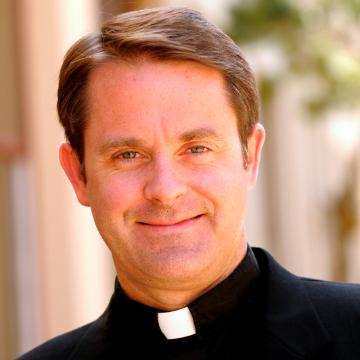
Are Sacred and Secular Journeys That Different?
Michael C. McCarthy S.J. '87 M.Div. '97
The long pilgrimage to Santiago de Compostela ends by standing in a long line. When you finally arrive in Santiago after walking 100 or more miles, you go the Pilgrim’s Office and stand in a long line to get a compostela (or “Certificate of Completion”). To show that you qualify, you present to the agent a credencial (or “Pilgrim’s Passport”) that every innkeeper stamped and dated.
And there you have a choice. On the application for the compostela, you are asked whether you made the pilgrimage for religious or non-religious reasons. Apparently, that determines whether you get a certificate in Latin indicating you did it pietatis causa (“for spiritual reasons”) or a certificate in a modern language.
In the final days of our 500-mile journey, my companion, Quentin, and I often discussed that distinction and what sense that distinction makes. We understood very well that not every pilgrim consciously identifies with all the symbolic meaning that surrounds the pilgrimage: Catholic prayers, the images of the saints, the churches and shrines, the rosaries and crosses, and so on. Many people do not want to be identified with the Catholic Church, or any church, or even any organized religion. Unlike medieval pilgrims, few of us were going to fulfill a penance or in order to ask St. James for a miracle.
And yet, as we came into the last few miles of our destination, Quentin and I began to see just how many people were making the Camino. In 2014, there were roughly a quarter of a million pilgrims, from many nations, including those that have few Christians.
When we made it to the Cathedral, it was so packed that we struggled to find a space where we could sit on the ground for Mass. The line to ascend the stairs in order to hug the big statue of St. James was so long that we decided to bypass one tradition.
When the botafumeiro (a huge silver urn that held burning embers and incense) swung over the large congregation pouring out smoke, people were in awe. The standard evening prayer repeats the words of the Psalmist: “O Lord, let my prayer like incense rise before you” (Ps. 141:2).
Were all those who walked hundreds of miles of this medieval pilgrimage for “non-religious reasons” all that different from us pilgrims who walked with a spiritual intention?
Although the Cathedral of Santiago de Compostela provides an amazing tourist spectacle, were all those who walked hundreds of miles of this medieval pilgrimage for “non-religious reasons” all that different from us pilgrims who walked with a spiritual intention?
Were those who thronged the cathedral because it is just such an impressive building all that different from those of us who knelt down to say our Catholic prayers?
I don’t think so.
Increasingly I have come to feel that the margins between “the sacred” and “the secular” are softer than we think. There are immense subtleties within that distinction that even scholars are beginning to question. Perhaps more than ever, we need to be asking questions.
For instance, the editors of a book, Rethinking Secularism, begin by indicating that “uncritical deployment of the categories of the religious and the secular severely limits the analysis of international politics and social change throughout the world.”
More than ever we need to be asking what may unite people who occupy both “sacred” and “secular” space in a way that is productive, brings peace, and human flourishing for (to use a Christian phrase) “the life of the world to come.”
Recent events in Paris and other places in the world suggest that, again, more than ever we need to be thinking carefully about our categories. More than ever we need to be asking what may unite people who occupy both “sacred” and “secular” space in a way that is productive, brings peace, and human flourishing for (to use a Christian phrase) “the life of the world to come.”
Dec 31, 2015

